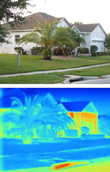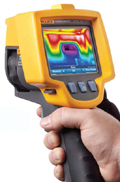Much of what Parker does as a worker in the public sector Chris Carroll does as a business owner. Carroll’s company, Carroll’s Inspection Services in Brownsville, Texas, does home inspections, energy audits, flat roof inspections, power panel inspections and related work in both residences and commercial buildings. Carroll said that he uses thermography mostly for energy audits.

WHY THERMOGRAPHY?
Thermography uses an IR camera (thermal imager) to capture two-dimensional representations of the surface temperatures of parts of buildings, including roofs, walls, doors, windows, and construction joints. Often, those images reveal temperatures or temperature differences that indicate conditions contributing to the waste of heated or cooled air and, as a result, needlessly excessive energy costs. In the case of Parker and his research, the imaging is often performed on new structures to determine their overall energy efficiency and/or the relative efficiency of the latest energy-saving building components.Carroll has been using a thermal imager in his work for about a year and a half and noted that it has allowed him to better serve his customers and is helping to increase his business. “For us, the thermal camera has been very valuable for energy inspections,” he acknowledged. “Used in conjunction with other test equipment, it really helps us identify and locate problems. Clients are often surprised when we can show them a visual representation of how much warm air is seeping into their air conditioned space.”

SLAB-ON-GRADE
Danny Parker described one situation where researchers were inspecting the inside of a building with a tile floor that was laid right up to the walls. It was summertime in Florida. So, it was quite hot outside. This building, like many in the Sun Belt, was built on a slab, and a thermal imager revealed some heat gain at the edge of the slab near the wall.The research team was also monitoring the floor with thermocouples in three or four places, but it was the thermal imager that found the important anomaly. “We saw something strange,” Parker recalled. “We saw that there was one spot on the floor on the south side that was cooler. It was about three to four inches across, and it extended out some distance from the wall. The areas around it were warmer. So, the question was, ‘What the heck is that?’”
While there were several possible explanations for the cooler spot, one possible answer was that something outside the building was blocking the sun from the slab and wall. “We went outside and looked, and we saw that there was a weed that had grown up by the side perimeter,” Parker reveals. “It was shading that area on the outside.”
Being researchers, Parker and his colleagues immediately saw the implications of their finding: could it be that shading a slab perimeter in a hot climate might be more useful than insulating it? Such a move is certainly easier and possibly less expensive than installing insulation. So, the researchers at FSEC are experimenting with planting ornamental grasses along half of the south-facing slabs of buildings, and leaving the other half bare for comparison.
INSPECTION POINTS
Often, Parker uses thermography to audit existing structures, especially those that are not performing up to expectations. He also uses thermal imaging to confirm that energy-saving devices installed by FSEC or being tested by the Center are doing the job.Carroll uses thermography in much the same way. “I get into attics and check for air leaks in the ductwork, insulation deficits, and things of that nature,” he said. He further explained that he is a RESNET (Residential Energy Service Network) certified energy rater1and uses his thermal imager in combination with a Duct Blaster® and a Blower Door™.
The Duct Blaster is a calibrated airflow measurement system used to test and document the air-tightness of forced air duct systems and to certify the quality of duct system installations.2“The Blower Door,” Carroll said, “is a fan that you set up in a door. It’s used to draw a vacuum on the house. So, I usually set it up, get the house as cool as possible, and create a vacuum in the house of about 50 Pascal. Then, the warm air from outside will seep through any holes in the house, and I can use the thermal camera to identify where those leaks are by identifying the warm spots on sheetrock or other components of the house.”
Carroll said that his thermal imager has increased the amount of business his company is securing. He said that in addition to using it to find air leaks in air conditioning systems and building envelopes, he uses it for pinpointing water penetration. (Wet areas heat and cool at different rates than dry areas, and the imager will detect such areas.)
ENERGY EFFICIENCY MODELING
Professional home energy auditors have at their disposal software packages that predict the energy efficiency of buildings based on the kinds of components and systems in them. The HERS (Home Energy Rating System) from RESNET, which Carroll is certified to use, is such a system. When the actual performance of a home does not meet calculated expectations, professionals such as Parker and Carroll can perform an on-site audit to locate the problem or problems. Both professionals pointed out that thermography is an indispensable tool in assessing why a house that should be doing well isn’t performing up to expectations.One problem endemic to the Sun Belt and reported by both Carroll and Parker results from the predominance of slab-on-grade construction there. “The air conditioning (a/c) engineers like to hide their work,” Parker noted. “So, the a/c system’s octopus (the splitting of the cooling distribution to individual rooms) is located in the attic space.”
Parker revealed that FSEC’s researchers have for some time been computing what the impact of this practice is. It is, to use his word, “deleterious.” He said that having a duct system in the attic means a loss of 25 percent to 30 percent of a cooling system’s potential during the hottest part of the day in the summer.

This is an IR image of a knee wall that separates an attic area from living space. In the center of the image is an a/c register. What the image vividly depicts is the heat gain to the duct system, a typical situation in attic duct systems. (Click on the image for an enlarged view.)
To illustrate his point, Parker refers to the thermal image on the camera pictured at right. “Since attic duct systems don’t work very well,” he said, “we’re working to find a way to get them inside the conditioned environment, insulate them better, or bury them in insulation.”
Slab-on-grade construction is also prevalent in Brownville, Texas, the area serviced by Carroll. “I’ve inspected 2,000 to 3,000 houses,” Carroll recalled. “All but about 10 percent were slab-on-grade, and the others were pier-and-beam construction. There are no basements; the water table is just too high.”
DUCT LEAKAGE
Carroll, who revealed that he does work related to the Energy Star program, described practices in his area: “Duct leakage has become a major issue, and down here, the air conditioning contractors cannot seem to solve the problem. There are massive leaks in the range of 300 cubic feet/ minute. Leakage should be less than six cfm per 100 square feet of conditioned space.”Carroll described the leakage problem as “a multi-fold, regional” problem. The energy auditor said that in his area the air handler is typically in a closet and the supply ducts in the attic.
So, when the ductwork leaks, the system is blowing air out of the house without adding air to the house. In essence, the leaking system is creating a partial vacuum in the living space and hot outside air leaks in wherever it can - around doors and windows, through outlets and electrical fixtures, etc. Of course, Carroll’s infrared camera documents the infiltration.
Parker and Carroll pointed out that their infrared cameras are useful in many other ways. For example, knee walls - vertical walls in attic spaces - are usually insulated, but often, because the insulation is installed vertically, it falls off. Missing insulation is very easy to find using an infrared camera. Another common problem detectable using thermography, besides missing insulation and unsealed a/c ducts, are uninsulated hot water pipes.
Sidebar: Potential Pitfalls With Thermal Imagers
Asked to share some potential problem areas faced by users of thermal imagers, Parker and Carroll mentioned the following:LACK OF SCALE SETTINGS
Some low-end IR cameras do not allow users to adjust the scales to compensate for different temperature ranges in different locations. “Make sure you get an imager that allows you to set the range and provides for using a consistent range for accurate comparisons,” Parker counseled.
LACK OF SOFTWARE AND FIRMWARE SUPPORT
Carroll said that when one is considering the purchase of a thermal camera it is essential to find out how well a company supports customers with software revisions and firmware updates. He reported that some makers of thermal cameras require their customers to send in the instrument and then charge for the updates. He believes such practices represent bad customer service, especially if the camera is a recent acquisition.
LACK OF COMPARATIVE ASSESSMENTS
In the same vein, Carroll believes there should be what he calls a “review page” that compares thermal cameras - price, features, customer support, etc. “Without such comparative assessments [like aConsumer Reportspage for thermal cameras], when you’re buying a thermal imager, you can only go by what the salesman tells you,” he said.
EMISSIVITY
“Be aware of objects in the image that have unusual emissivity,” Parker said. “For instance, foils and metal surfaces can give false readings. (Emissivity is the relative ability of a surface to radiate energy as compared with a perfectly black surface.) “Say you’re looking at something in an image that’s metal, perhaps a shiny pipe,” Parker suggested. “It would probably give a poor indication relative to what its real temperature is. One of the tricks to get around that is to apply paint or electrical tape, which has a higher emissivity than the pipe.”
REFLECTIVITY
Parker mentioned that surfaces that reflect light such as bright floors or walls, mirrors, windows, and the like will also produce false readings.
SEASONAL CONSIDERATIONS
Carroll said that one of his biggest problems is doing energy audits in the spring and fall. “Because thermal imaging detects temperature differences,” he said, “when it’s 78 degrees inside and 78 degrees outside, it’s harder to get a big temperature difference.” He said that it’s much easier to do the work during the middle of summer, especially at dawn or dusk, when the thermal differentiation is the greatest.
Footnotes:
1According to its website, RESNET is an industry not-for-profit membership organization as well as a national standards making body for building energy-efficiency rating systems. Its standards are recognized by the mortgage industry for capitalizing energy efficiency in mortgages and by the financial industry for certification of energy efficiency credits. RESNET standards are also recognized by the federal government for verification of building energy performance for: 1) federal tax credit qualification, 2) EPA Energy Star labeled homes, and 3) the U.S. Department of Energy Building America program. In addition, RESNET standards serve as minimum code compliance in 16 states. For more information, visit www.resnet.us.
2According to information on The Energy Conservatory’s website, www.energyconservatory.com, the Duct Blaster is the preferred system for California’s Title 24 (Building Standards Code), as well as for compliance testing in Florida and Texas and for Energy Star testing throughout the country.
Reprinted with permission from the Fluke Application Note “Using thermography to reduce residential energy use.” For more information, visit www.fluke.com.
Publication date:01/10/2011

Report Abusive Comment